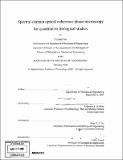Spectral-domain optical coherence phase microscopy for quantitative biological studies
Author(s)
Joo, Chulmin, 1976-
DownloadFull printable version (26.09Mb)
Other Contributors
Massachusetts Institute of Technology. Dept. of Mechanical Engineering.
Advisor
Johannes F. de Boer.
Terms of use
Metadata
Show full item recordAbstract
Conventional phase-contrast and differential interference contrast microscopy produce high contrast images of transparent specimens such as cells. However, they do not provide quantitative information or do not have enough sensitivity to detect nanometerlevel structural alterations. We have developed spectral-domain optical coherence phase microscopy (SD-OCPM) for highly sensitive quantitative phase imaging in 3D. This technique employs common-path spectral-domain optical coherence reflectometry to produce depth-resolved reflectance and quantitative phase images with high phase stability. The phase sensitivity of SD-OCPM was measured as nanometer-level for cellular specimens, demonstrating the capability for detecting small structural variation within the specimens. We applied SD-OCPM to the studies of intracellular dynamics in living cells and the detection of molecular interactions on activated surfaces as a sensor application.In the study of intracellular dynamics, we measured fluctuation of localized field-based dynamic light scattering within cellular specimens. With its high sensitivity to amplitude and phase fluctuations, SD-OCPM could observe the existence of two different regimes in intracellular dynamics. We also investigated the effect of an anti-cancer drug, Colchicine and ATP-depletion on the intracellular dynamics of human ovarian cancer cells, and observed the modification in diffusion characteristics inside the cells. Based on the optical sectioning capability of SD-OCPM, quantitative phase imaging was performed to examine slow dynamics of living cells. Through time-lapsed imaging and spectral analysis on the dynamics at the vicinity of cell membrane, we observed the existence of dynamic and independent sub-domains inside the cells that fluctuate at various dominant frequencies with different frequency contents and magnitudes.SD-OCPM was further utilized to measure molecular interactions on activated sensor surfaces. (cont) The method is based on the fact that phase varies as analyte molecules bind to the immobilized probe molecules at the sensing surface and SD-OCPM can measure small phase alteration at any surface with high sensitivity. We have measured a -1.3 nm increase in optical thickness due to the binding of streptavidin on a biotin-activated substrate in a micro-fluidic device. Moreover, SD-OCPM was extended to image protein array chips, demonstrating its potential as a multiplexed protein array scanner.
Description
Thesis (Ph. D.)--Massachusetts Institute of Technology, Dept. of Mechanical Engineering, 2008. Includes bibliographical references.
Date issued
2008Department
Massachusetts Institute of Technology. Department of Mechanical EngineeringPublisher
Massachusetts Institute of Technology
Keywords
Mechanical Engineering.